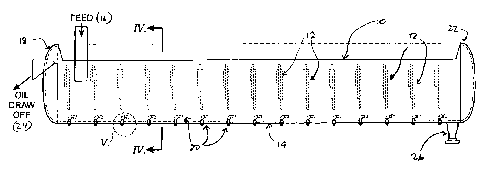Some of the information on this Web page has been provided by external sources. The Government of Canada is not responsible for the accuracy, reliability or currency of the information supplied by external sources. Users wishing to rely upon this information should consult directly with the source of the information. Content provided by external sources is not subject to official languages, privacy and accessibility requirements.
Any discrepancies in the text and image of the Claims and Abstract are due to differing posting times. Text of the Claims and Abstract are posted:
| (12) Patent: | (11) CA 2455239 |
|---|---|
| (54) English Title: | SAND SEPARATION VESSEL |
| (54) French Title: | RECIPIENT POUR LA SEPARATION DU SABLE |
| Status: | Term Expired - Post Grant Beyond Limit |
| (51) International Patent Classification (IPC): |
|
|---|---|
| (72) Inventors : |
|
| (73) Owners : |
|
| (71) Applicants : |
|
| (74) Agent: | BENNETT JONES LLP |
| (74) Associate agent: | |
| (45) Issued: | 2011-04-12 |
| (22) Filed Date: | 2004-01-15 |
| (41) Open to Public Inspection: | 2005-07-15 |
| Examination requested: | 2008-01-22 |
| Availability of licence: | N/A |
| Dedicated to the Public: | N/A |
| (25) Language of filing: | English |
| Patent Cooperation Treaty (PCT): | No |
|---|
| (30) Application Priority Data: | None |
|---|
A vessel for separating sand and other solid particulate matter from heavy oil and other hydrocarbons includes a horizontally disposed vessel having a plurality of internal weirs. There are gaps below the weirs along the bottom of the vessel where wash jets provide fluid force to move the sand along the bottom of the vessel and provide agitation. The wash fluid may comprise known surfactants or solvents. The solids may be introduced into the vessel at a first end and collected from a solids outlet at a second end. Oil may be skimmed from the top of the vessel with an oil outlet or skimmer.
Un récipient permettant de séparer du sable et d'autres matières particulaires solides de pétrole lourd et d'autres hydrocarbures comprenant un récipient disposé horizontalement muni de plusieurs déversoirs. Des espaces sont placés sous les déversoirs le long de la partie inférieure du récipient où des jets de lavage fournissent une force de fluide pour déplacer le sable le long de la partie inférieure du récipient et fournir un brassage. Le fluide de lavage peut comprendre un solvant ou des agents de surface connus. Les solides peuvent être introduits dans le récipient à une première extrémité et rassemblés d'une sortie de solides à une deuxième extrémité. Le pétrole peut être écumé à partir de l'extrémité supérieure du récipient avec une sortie de pétrole ou une écumoire.
Note: Claims are shown in the official language in which they were submitted.
Note: Descriptions are shown in the official language in which they were submitted.

2024-08-01:As part of the Next Generation Patents (NGP) transition, the Canadian Patents Database (CPD) now contains a more detailed Event History, which replicates the Event Log of our new back-office solution.
Please note that "Inactive:" events refers to events no longer in use in our new back-office solution.
For a clearer understanding of the status of the application/patent presented on this page, the site Disclaimer , as well as the definitions for Patent , Event History , Maintenance Fee and Payment History should be consulted.
| Description | Date |
|---|---|
| Inactive: Expired (new Act pat) | 2024-01-15 |
| Letter Sent | 2023-07-17 |
| Letter Sent | 2023-01-16 |
| Common Representative Appointed | 2019-10-30 |
| Common Representative Appointed | 2019-10-30 |
| Grant by Issuance | 2011-04-12 |
| Inactive: Cover page published | 2011-04-11 |
| Pre-grant | 2011-01-31 |
| Inactive: Final fee received | 2011-01-31 |
| Notice of Allowance is Issued | 2010-12-22 |
| Letter Sent | 2010-12-22 |
| Notice of Allowance is Issued | 2010-12-22 |
| Inactive: Approved for allowance (AFA) | 2010-12-10 |
| Amendment Received - Voluntary Amendment | 2010-09-07 |
| Inactive: S.30(2) Rules - Examiner requisition | 2010-03-04 |
| Inactive: S.29 Rules - Examiner requisition | 2010-03-04 |
| Letter Sent | 2008-03-19 |
| Request for Examination Received | 2008-01-22 |
| Request for Examination Requirements Determined Compliant | 2008-01-22 |
| All Requirements for Examination Determined Compliant | 2008-01-22 |
| Inactive: Office letter | 2006-10-11 |
| Inactive: Corrective payment - s.78.6 Act | 2006-09-29 |
| Inactive: Entity size changed | 2005-11-01 |
| Application Published (Open to Public Inspection) | 2005-07-15 |
| Inactive: Cover page published | 2005-07-14 |
| Letter Sent | 2004-04-16 |
| Inactive: IPC assigned | 2004-04-07 |
| Inactive: First IPC assigned | 2004-04-07 |
| Inactive: Single transfer | 2004-03-15 |
| Inactive: Courtesy letter - Evidence | 2004-03-02 |
| Inactive: Filing certificate - No RFE (English) | 2004-02-25 |
| Filing Requirements Determined Compliant | 2004-02-25 |
| Application Received - Regular National | 2004-02-25 |
There is no abandonment history.
The last payment was received on 2010-11-15
Note : If the full payment has not been received on or before the date indicated, a further fee may be required which may be one of the following
Please refer to the CIPO Patent Fees web page to see all current fee amounts.
Note: Records showing the ownership history in alphabetical order.
| Current Owners on Record |
|---|
| PAT PAGE |
| JACK MONKMAN |
| Past Owners on Record |
|---|
| COLIN PAGE |